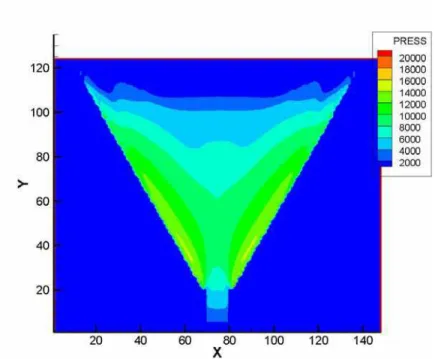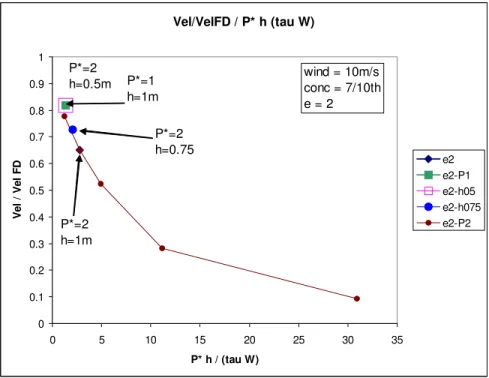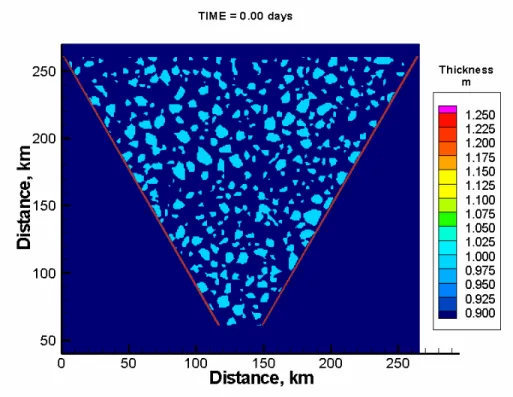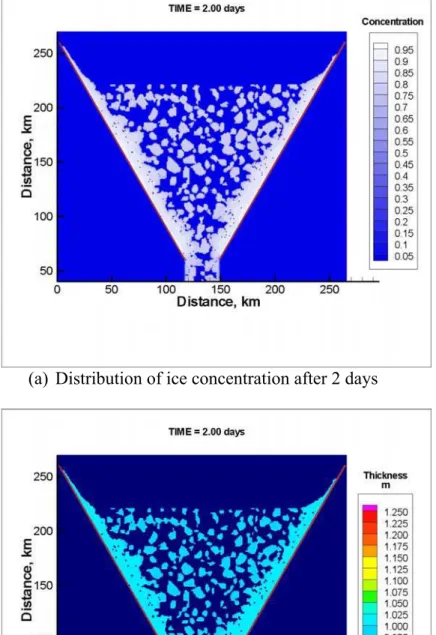Publisher’s version / Version de l'éditeur:
Vous avez des questions? Nous pouvons vous aider. Pour communiquer directement avec un auteur, consultez la
première page de la revue dans laquelle son article a été publié afin de trouver ses coordonnées. Si vous n’arrivez pas à les repérer, communiquez avec nous à PublicationsArchive-ArchivesPublications@nrc-cnrc.gc.ca.
Questions? Contact the NRC Publications Archive team at
PublicationsArchive-ArchivesPublications@nrc-cnrc.gc.ca. If you wish to email the authors directly, please see the first page of the publication for their contact information.
https://publications-cnrc.canada.ca/fra/droits
L’accès à ce site Web et l’utilisation de son contenu sont assujettis aux conditions présentées dans le site LISEZ CES CONDITIONS ATTENTIVEMENT AVANT D’UTILISER CE SITE WEB.
Technical Report (National Research Council of Canada. Canadian Hydraulics Centre); no. CHC-TR-073, 2010-05-01
READ THESE TERMS AND CONDITIONS CAREFULLY BEFORE USING THIS WEBSITE. https://nrc-publications.canada.ca/eng/copyright
NRC Publications Archive Record / Notice des Archives des publications du CNRC :
https://nrc-publications.canada.ca/eng/view/object/?id=0a81033a-0507-427d-aa16-e365637288f5 https://publications-cnrc.canada.ca/fra/voir/objet/?id=0a81033a-0507-427d-aa16-e365637288f5
Archives des publications du CNRC
For the publisher’s version, please access the DOI link below./ Pour consulter la version de l’éditeur, utilisez le lien DOI ci-dessous.
https://doi.org/10.4224/17506215
Access and use of this website and the material on it are subject to the Terms and Conditions set forth at
The flow of continuous and broken ice covers through converging channels
The Flow of Continuous and Broken Ice Covers through
Converging Channels
Mohamed Sayed and Ivana Kubat Canadian Hydraulics Centre National Research Council of Canada
Ottawa, Ont. K1A 0R6 Canada
Technical Report CHC-TR-073
ABSTRACT
The present report describes work done during 2009/2010, whish is part of a project aimed at clarifying two issues: (1) the formation of landfast ice; and (2) the influence of floe size on the drift and deformation of ice covers. The flow through converging channel is used as means to examining those two issues. The present work achieved the following:
(1) Established a criterion that quantifies the mobility of ice covers as they flow through constrictions. A dimensionless relationship was found which governs the level of restriction to ice flow.
(2) Tensile strength of the ice cover was introduced. The results establish the
feasibility of incorporating the tensile strength in the forecasts. Moreover, the role of tensile strength on the mobility of ice through restrictions was evaluated. (3) Tests have established a feasible method for modeling the drift and deformation
of individual floes. The results show qualitatively the manner in which individual flows interact as they pass through a constriction. The results form a basis for quantifying the role of floe sizes on the dynamics of ice covers.
The report includes suggestions for employing the present conclusions in subsequent efforts towards achieving the ultimate objectives of the overall project.
TABLE OF CONTENTS
1.0 INTRODUCTION ... 9
2.0 TEST CASE... 10
3.0 FLOW CRITERION FOR CONVERGING CHANNELS ... 12
4.0 THE ROLE OF ICE PROPERTIES ... 14
5.0 TENSILE STRENGTH ... 14
6.0 DISCRETE FLOES ... 17
7.0 CONCLUSIONS... 20
LIST OF FIGURES
Figure 1: Sketch of the test case ... 10 Figure 2: Distributions of ice concentration, thickness and pressure after 8 days from the start of the simulation. The horizontal and vertical axes show node numbers (cell size= 2.5 km)... 12 Figure 3: Plot of the relationship between the two dimensionless numbers, u’ and F . The results are for a Hibler’s yield envelope parameter e= 2 ... 13 Figure 4: Plots of u’ versus F, for e=1.2, 1.5 and 2. ... 14 Figure 5: The yield envelope of Savage (2008)... 15 Figure 6: Distributions of ice concentration and thickness after 8 days from the start of
simulation, Pt / Pc = 0.2. ... 16
Figure 7: Plot of of u’ versus F, for an ice cover with tensile strength, Pt / Pc = 0.2... 16
Figure 8: Initial condition for simulation of individual floes drift through a converging channel ... 18 Figure 9: Resulting distributions of ice concentration and thickness after 2 days from the start. The plots show the changes to packing, drift and deformation of the individual floes... 19
The Flow of Continuous and Broken Ice Covers through
Converging Channels
1.0 INTRODUCTION
The work described in this report has two ultimate objectives. The first is to examine aspects of landfast ice formation. The second objective is to establish means for quantifying the effect of ice floe size on the drift of ice covers. In order to achieve those objectives, the present work focuses on incorporating the following factors in simulations of ice flow: the introduction of tensile strength, modeling individual floes, and the development of a criterion for the flow of ice covers through constrictions.
The flow of ice covers through converging channels presents a convenient situation for examining both landfast ice formation and the role of floe sizes on ice drift and deformation. Landfast ice forms when the ice cover freezes into a solid sheet (in contrast to broken floes) and adheres to the shorelines. The ice cover remains landfast as long as the forcing of wind and current does not break the ice cover or the bonds to the shoreline. The yield condition used in operational forecasting does not include the tensile strength that is needed to maintain stationary landfast ice. The examination of ice cover behaviour during passage through converging channels includes tests of the role of tensile strength. The simulations show cases where landfast ice forms along the sides of the channel. The results provide the following:
• Predicting some of the conditions that lead to landfast ice formation.
• Guidance for choosing the appropriate representation of the tensile strength in operational forecast models.
Simulating the interaction between individual floes is a prerequisite for evaluating the effect of floe size. In order to appropriately represent the interaction between floes, the numerical simulations must have sufficient spatial resolution. Moreover, the tensile strength, which keeps each floe relatively intact, needs to be taken into account. Boundary conditions at the edges of the floes may also introduce complications. In order to quantify the role of floe sizes, the flow through converging channels (or constrictions) is first examined. The present work develops a criterion for the flow of continuous ice covers through such constrictions. That criterion can then be extended to quantify the role of floe sizes.
The present work builds on an earlier study of ice flow through converging channels by Kubat et al. (2006). That reference includes a review of relevant literature and a description of the formulation of the ice dynamics model. Consequently, such background will not be repeated in this report. The present work also employs Savage’s (2008) formulation of a yield envelope that includes the tensile strength. Details of that
formulation are not repeated here as well. The development of a criterion for the flow through converging channels follows suggestions made by Flato (2010).
This report describes the work carried out during 2009/2010. The work includes the development of a criterion for the flow through converging channels, incorporating the tensile strength, and preliminary tests that illustrate the feasibility of simulating the interactions and deformations of multiple individual floes.
2.0 TEST CASE
The geometry used in the simulation is shown in Figure 1. A steady uniform wind acts downwards to drive the ice through the exit of the converging channel. Water current is zero, and Coriolis force is neglected. Thus the flow would be nearly symmetrical around the centre line of the channel. The ice cover starts with uniform thickness and concentration. Several test runs were done using a range of values for the initial ice thickness, concentration and wind velocity. As an example of the output, the resulting distributions of ice concentration, thickness and pressure (mean normal stress) are shown in Figure 2. Those distributions represent conditions after 8 days from the start of a simulation. The test case also uses Hibler’s elliptical yield envelop with the following parameter values: P* = 2 x 104 N/m and e=2. A rectangular grid of 2.5 km cell size is used in the calculations.
Figure 1: Sketch of the test case
The results shown in Figure 2 correspond to an initial ice thickness of 1 m, initial concentration of 0.7, and wind velocity of 10 m/s.
(a) Distribution of ice concentration
(c) Distribution of the pressure (mean normal stress)
Figure 2: Distributions of ice concentration, thickness and pressure after 8 days from the start of the simulation. The horizontal and vertical axes show node numbers (cell size= 2.5 km)
3.0 FLOW CRITERION FOR CONVERGING CHANNELS
Flato (2010) suggested that a dimensionless number representing the ratio between the driving force and resistance (due to ice strength) may characterize the restriction to the flow. At one extreme, when ice strength is relatively low and land boundaries offer no constriction, the ice would move at the free drift velocity. On the other extreme, when ice is relatively strong and land boundaries restrict the flow, arching may occur and the flow would completely stop. The effect of the constriction is thus examined using two dimensionless groups.
The first dimensionless term, representing the relative velocity of the ice is
freedrift exit
u u
u′= (1)
where uexit is the velocity at the exit. We consider that exit velocity is represented by the
free drift
obtained when ice strength is set to zero.
The second dimensionless number, F, is given by W h P F τ * = (2)
where P* is the familiar Hibler’s strength parameter, h is ice thickness, τ is the forcing shear stress (due to wind), and W is the width of the exit. Note that the nominator in Eq. 2 represents the resistance to flow, and the denominator represents the driving force. Thus, a small value of F corresponds to near free drift conditions. A high value for F signifies relatively large resistance to flow and a potential for arching.
The hypothesis of using the dimensionless numbers u’ and F to represent flow through constrictions was tested using a range of variables. Different values of P*, h, wind velocity were used. Figure 3 shows the results, which all fall on a single line that represents the expected relationship between u’ and F . The results are obtained using a Hibler’s yield ellipse with a parameter e=2. The initial concentration is 0.7. A number of runs has shown that the initial concentration has negligible role because the ice cover compacts to concentrations near unity shortly after the start of the simulations (see Fig. 2a). Vel/VelFD / P* h (tau W) 0 0.1 0.2 0.3 0.4 0.5 0.6 0.7 0.8 0.9 1 0 5 10 15 20 25 30 35 P* h / (tau W) Ve l / Ve l F D e2 e2-P1 e2-h05 e2-h075 e2-P2 wind = 10m/s conc = 7/10th e = 2 P*=1 h=1m P*=2 h=0.5m P*=2 h=1m P*=2 h=0.75
Figure 3: Plot of the relationship between the two dimensionless numbers, u’ and F . The results are for a Hibler’s yield envelope parameter e= 2
4.0 THE ROLE OF ICE PROPERTIES
The compressive strength, or P*, is already included in the dimensionless number F. The shear strength of the ice cover, however, may affect the relationship shown in Fig. 3. Runs using different values for Hibler’s yield envelope parameter, e, were done. Smaller values of e represent higher shear strength, and consequently lower velocities. The resulting plots of u’ versus F are shown in Figure 4.
Vel/VelFD / P* h (tau W) 0 0.1 0.2 0.3 0.4 0.5 0.6 0.7 0.8 0.9 1 0 5 10 15 20 25 30 35 P* h / (tau W) Vel / Vel FD e2 e1_2 e1_5 wind = 15m/s wind = 3m/s wind = 5m/s wind = 7.5m/s wind = 10m/s h = 1m conc = 7/10th P* = 2x10e04
Figure 4: Plots of u’ versus F, for e=1.2, 1.5 and 2.
5.0 TENSILE STRENGTH
Incorporating the tensile strength is a necessary precursor for modeling the interaction between discrete floes. Savage (2008) developed a formulation that extends Hibler’s elliptical yield envelop to include tensile strength. The resulting yield envelope is shown in Figure 5. The tensile strength is represented by the parameter Pt, while the compressive
strength is represented by Pc. Note that the yield envelope reduces to the familiar Hibler’s
ellipse when Pt =0 and Pc = P*.
Simulation results are shown here for a ratio of Pt / Pc = 0.2. The initial conditions are: ice
thickness= 1.5 m, and concentration= 0.7. Wind velocity is 10 m/s. Figure 6 shows the concentration and thickness after 8 days from the start of the simulation. Note that an arch forms across the exit. The effect of the tensile strength on the criterion of the flow through constrictions was also examined. The resulting plot of u’ versus F is shown in Figure 7. As expected, the tensile strength reduces the dimensionless number u’.
Figure 5: The yield envelope of Savage (2008).
(b) Distribution of ice thickness.
Figure 6: Distributions of ice concentration and thickness after 8 days from the start of simulation, Pt / Pc = 0.2. 0 0.1 0.2 0.3 0.4 0.5 0.6 0.7 0.8 0.9 1 0 1 2 3 4 5 Series1
6.0 DISCRETE FLOES
Preliminary tests were done to examine the feasibility of simulating individual floes. The resolution is relatively high with cell size of 1 km. The tensile strength is introduced using a ratio Pt / Pc = 0.2. Geometry of the floes was obtained by digitizing some typical
floes from available imagery. The intent at this stage is to have representative shapes without accurately accounting for particular sizes or geometries. As an example of the tests the initial distribution of concentration and thickness is shown in Figure 8. The initial thickness is 1 m. The concentration within each floe is 1. The bulk or average concentration is obviously much lower at approximately 0.5. The wind velocity is 10 m/s. The resulting values of concentration and thickness after two days are shown in Figure 9. The results indicate that simulation of the drift and deformation of individual floes is feasible. The preliminary results are not sufficient though to establish the effect of floe size on the flow criterion. Further testing would be needed.
(b) The initial distribution of ice thickness showing individual floes.
Figure 8: Initial condition for simulation of individual floes drift through a converging channel
(a) Distribution of ice concentration after 2 days
(b) Distribution of ice thickness after 2 days
Figure 9: Resulting distributions of ice concentration and thickness after 2 days from the start. The plots show the changes to packing, drift and deformation of the individual floes
7.0 CONCLUSIONS
The present report describes work done during 2009/2010, which is part of a project aimed at clarifying two issues: (1) the formation of landfast ice; and (2) the influence of floe size on the drift and deformation of ice covers. The flow through converging channel is used as means to examining those two issues. The present work achieved the following:
(4) Established a criterion that quantifies the mobility of ice covers as they flow through constrictions. A dimensionless relationship was found which governs the level of restriction to ice flow.
(5) Tensile strength of the ice cover was introduced. The results establish the
feasibility of incorporating the tensile strength in the forecasts. Moreover, the role of tensile strength on the mobility of ice through restrictions was evaluated. (6) Tests have established a feasible method for modeling the drift and deformation
of individual floes. The results show qualitatively the manner in which individual flows interact as they pass through a constriction. The results form a basis for quantifying the role of floe sizes on the dynamics of ice covers.
The results of the present work lay the foundation for quantifying the extent of landfast ice along the shorelines of converging channels. Future work can examine the velocity profiles to determine zones for the potential development of landfast ice, and to determine the role of environmental forcing and land geometry. The results can also be extended to quantify the effect of floe size on the drift of ice covers through constrictions and through narrow channels
8.0 REFERENCES
Flato, G. (2010). “Personal communications”.
Kubat, I, Sayed, M., Savage, S.B., and Carrieres, T. (2006). “Flow through converging channels,” International Journal of Offshore and Polar Engineering, Vol. 106, No. 4, pp. 268-273.
Savage, S.B. (2008). “Elliptical yield function for modeling cohesion resulting from freeze-bonding in sea ice fields,” Report to the Canadian Hydraulics Centre, National Research Council, February 27, 2008.







